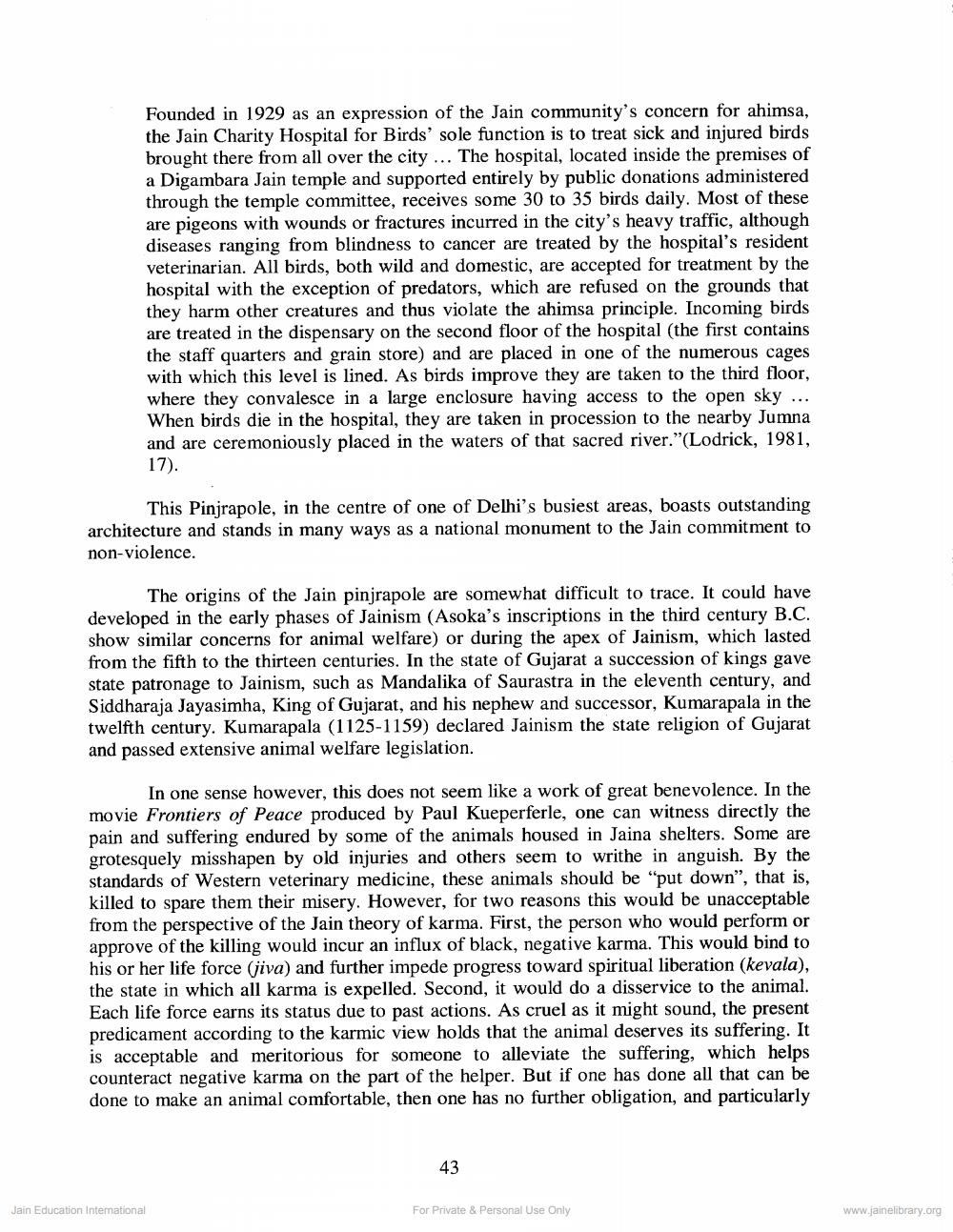________________
Founded in 1929 as an expression of the Jain community's concern for ahimsa, the Jain Charity Hospital for Birds' sole function is to treat sick and injured birds brought there from all over the city ... The hospital, located inside the premises of a Digambara Jain temple and supported entirely by public donations administered through the temple committee, receives some 30 to 35 birds daily. Most of these are pigeons with wounds or fractures incurred in the city's heavy traffic, although diseases ranging from blindness to cancer are treated by the hospital's resident veterinarian. All birds, both wild and domestic, are accepted for treatment by the hospital with the exception of predators, which are refused on the grounds that they harm other creatures and thus violate the ahimsa principle. Incoming birds are treated in the dispensary on the second floor of the hospital (the first contains the staff quarters and grain store) and are placed in one of the numerous cages with which this level is lined. As birds improve they are taken to the third floor, where they convalesce in a large enclosure having access to the open sky ... When birds die in the hospital, they are taken in procession to the nearby Jumna and are ceremoniously placed in the waters of that sacred river."(Lodrick, 1981,
17).
This Pinjrapole, in the centre of one of Delhi's busiest areas, boasts outstanding architecture and stands in many ways as a national monument to the Jain commitment to non-violence.
The origins of the Jain pinjrapole are somewhat difficult to trace. It could have developed in the early phases of Jainism (Asoka's inscriptions in the third century B.C. show similar concerns for animal welfare) or during the apex of Jainism, which lasted from the fifth to the thirteen centuries. In the state of Gujarat a succession of kings gave state patronage to Jainism, such as Mandalika of Saurastra in the eleventh century, and Siddharaja Jayasimha, King of Gujarat, and his nephew and successor, Kumarapala in the twelfth century. Kumarapala (1125-1159) declared Jainism the state religion of Gujarat and passed extensive animal welfare legislation.
In one sense however, this does not seem like a work of great benevolence. In the movie Frontiers of Peace produced by Paul Kueperferle, one can witness directly the pain and suffering endured by some of the animals housed in Jaina shelters. Some are grotesquely misshapen by old injuries and others seem to writhe in anguish. By the standards of Western veterinary medicine, these animals should be "put down”, that is, killed to spare them their misery. However, for two reasons this would be unacceptable from the perspective of the Jain theory of karma. First, the person who would perform or approve of the killing would incur an influx of black, negative karma. This would bind to his or her life force (jiva) and further impede progress toward spiritual liberation (kevala), the state in which all karma is expelled. Second, it would do a disservice to the animal. Each life force earns its status due to past actions. As cruel as it might sound, the present predicament according to the karmic view holds that the animal deserves its suffering. It is acceptable and meritorious for someone to alleviate the suffering, which helps counteract negative karma on the part of the helper. But if one has done all that can be done to make an animal comfortable, then one has no further obligation, and particularly
43
Jain Education International
For Private & Personal Use Only
www.jainelibrary.org




